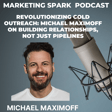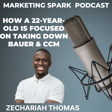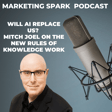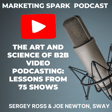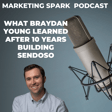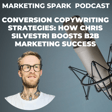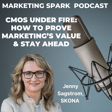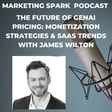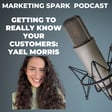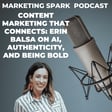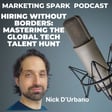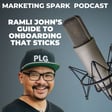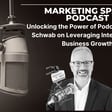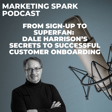Become a Creator today!Start creating today - Share your story with the world!
Start for free
00:00:00
00:00:01

Taking the Right Approach to ABM
In simple terms, account-based marketing (ABM) is about targeting the prospects that really matter.
It's about a laser-focused approach to marketing and sales.
Behind the scenes, however, a lot needs to happen. It includes ensuring that marketing and sales work together to attract, engage, and nurture prospects.
On this episode of Marketing Spark, Andrei Zinkevich also points out that ABM also involves determining the customers that you don't want as much as the customers you do want.
Andrei goes into depth about how his company, Full Funnel, helps B2B SaaS companies leverage ABM to drive leads and revenue growth.
Transcript
Introduction to ABM and Guest Introduction
00:00:05
Speaker
Hey, it's Mark Evans, and you're listening to Marketing Spark. In the B2B world, you hear a lot about ABM, or account-based marketing. In simple terms, it involves focusing on a small number of companies to drive marketing and sales engagement and efficiencies.
00:00:21
Speaker
practice. There are many moving parts. To get insight into ABM and how it has been evolving, I'm excited to be talking with Andrei Zinkovic, co-founder of FullFunnel.io. Welcome to the podcast, Andrei. Thanks a lot for having me, Mark.
How B2B SaaS Companies Utilize ABM
00:00:37
Speaker
Super excited to chat with you about ABM and all things related to competition with Mark. We've got a lot to cover. There's so much insight that you offer on LinkedIn, and I'm excited to get into it. But let's start with ABM.
00:00:51
Speaker
You hear a lot about it as companies, B2B, B2B SaaS companies look to leverage it from a marketing and sales perspective to really hone in on the prospects who matter.
Misconceptions and Fundamentals of ABM
00:01:01
Speaker
What's going on? What is the state of ABM? How has it changed over the last 18 months?
00:01:07
Speaker
I believe that ABM is a topic that gets lots of hype. And it's just because as anything in marketing, ABM, demand generation, print marketing, etc., these are work marketing terms that are not really clear to the companies. Lots of companies don't have marketing background and they rely on the content of MarTech
00:01:32
Speaker
vendors and their knowledge of ABM is limited to the blog posts, ebooks, webinars produced by the Martek vendors. And that's the huge problem because in a majority of cases, whenever I talk to non-marketing executive, I mean executive who doesn't have a background in marketing and I ask, what's your take on ABM? What does it mean to you?
00:01:57
Speaker
in most cases people describe it and a little bit generalizing of course right now but in most cases people describe it as display ads as a warm-up play and outbound so nice news here so it's just display ads that are pretended to warm up strategic accounts and then it's a kind of
00:02:19
Speaker
outreach sequence and that's it. But the truth is that count-based marketing is just as specific or what we used to call it laser targeted approach when
Challenges in Implementing ABM
00:02:31
Speaker
you do an appropriate account list building, we can cover this. And the accounts that are included in your list are not just only the accounts that fit your, let's say demographic criteria, pharmacographic criteria, but the accounts that have an existing need in your services, somehow they
00:02:53
Speaker
show the interest in the product like this. You have some sort of engagement and you know that your product might help to achieve their goals or fulfill their existing needs. So that's the key. And your approach, in most cases, you know, there are lots of talks that ABM has different place like one-to-one, one-to-few, one-to-many, but the truth is that account-based marketing
00:03:21
Speaker
originates from one-to-one approach. It means that you deliver a specific warm-up program and a specific solution to a specific company, like Andrey Zinkovich is offering something to Mark Evans to help him to achieve his goals. And that's the difference from mass marketing. The biggest problem is that lots of companies
00:03:44
Speaker
don't realize this, they don't have enough skill set and that's why they rely heavily on the content that is available and they tend to think that it's just enough to purchase expensive IBM software because this way you'll be more advanced or whatever.
00:04:03
Speaker
they think that they will be. It's enough to pour more money into display ads and then just do the outreach. That's the biggest problem I'm seeing right now, and that's the huge gap. The companies that understand how to do the ABM the right way are crawling really fast. That's a lot of information to digest in a short period of time. You mentioned list building.
00:04:33
Speaker
And it does sort of strike me that how does a company who's interested in ABM start the process? What should they do first to make sure that they do it in the right way from the beginning? Yeah, absolutely.
Aligning Marketing with Customer Behavior
00:04:46
Speaker
First of all, before launch an annual program, not only ABM.
00:04:51
Speaker
You should do the fundamentals the right way, which means that you should know what verticals are the most profitable and the most creative to your business. The next step is understanding the needs, the goals of the prospects of the accounts from this specific vertical.
00:05:11
Speaker
And the way, how do they purchase your products? That's crucial. So in this case, and this is how you build your ideal customer profile. It's not just about saying, hey, I want to prospect startups from North America with this team size, you know, and this revenue level.
00:05:30
Speaker
Now, the goal is to identify the common criteria or let's say the common patterns or features of your best customers, then run customer interviews to understand what triggers them to start looking for products like yours. How do they use these products? How do they run their research with whom they advise?
00:05:51
Speaker
what influences their decision-making process. Let's say what questions are being discussed at in-house meetings when they are considering products like yours. And this is crucial because this is the only way how you can develop your marketing and sales process. Your marketing and sales process should be based on how your customers are buying, not how you tend to think they are buying. So this is crucial before launching any program, not only ABM.
00:06:21
Speaker
So when it's done, then the next step is discussing account qualification and disqualification criteria. I have heard a lot about qualification and usually it's all about team size revenue, geographical area, etc. But the truth is that there are so many
00:06:40
Speaker
non-standard or unique criteria for every vertical app. Let's make a precise example. So with one software development company, we narrowed their focusing on positioning and then we were looking, one of the account qualification criteria was that, let's say the product team of this specific target accounts should have mobile SDK in their LinkedIn profile description, because we knew if they had this
00:07:08
Speaker
Let's say in their title, this mobile SDK was a key priority, so they could fit with their service, you know, these specific accounts. And if they didn't have it, then it means that mobile SDK is the lowest priority. And for us, that was a huge qualification criteria.
00:07:26
Speaker
We didn't waste time on the wrong accounts. Next up is disqualification.
Account Warming Beyond Display Ads
00:07:31
Speaker
I have rarely seen that anybody talks about disqualification, but the truth is that not all accounts are good fit for you, even if they fit your revenue team size.
00:07:42
Speaker
geographical criteria. The truth is, let's take this specific example I just shared. So in this case, the disqualification criteria was if CTO or VP of IT had a baccalaureate degree in post-Soviet countries or India. And the only reason for this why we disqualified these accounts because usually they have had strong network or connections in these countries and they could
00:08:10
Speaker
find a cheaper vendor for these specific services. So that was another disqualification criteria, which is not obvious. Or in one example service, one enterprise fintech company, as a disqualification criteria, we had two points. If we were prospecting chief financial officer, so CFOs, and if they were the first year on their position, or if they spent more than five years
00:08:38
Speaker
at the same position, at the same company, we just qualified these people because the truth is again, the truth was that if it was their first year, they didn't want to change anything. And if they spent more than five years, it means that they have already established some specific process and they had a software and again, they were not willing to change.
00:09:01
Speaker
The way how we view it, again, by writing in-depth customer interviews, asking the questions that I have already mentioned, and understanding. So that's crucial. And then, again, these are the key points, and then you need to understand two more things. Before reaching out,
00:09:21
Speaker
you should warm up accounts. And again, we just touched this. Forming up is not just pouring more money into IP-based display ads. Because the truth is, I know Chris Volker actually articulated this issue really good.
00:09:38
Speaker
So look, web people spend most of their day. They use CRM systems, they use Slack, email, they use Asana, whatever, notion for project management. And they spend 90% of their time in this software. And you won't be able to target them with display ads. Not everybody is hanging out on LinkedIn as lots of vendors. And format
00:10:05
Speaker
We can obviously touch it. You should do completely different things when it comes to warm up. And then activation. When it comes to activation, you should set up a specific account engagement threshold.
Importance of Aligning Marketing and Sales
00:10:19
Speaker
you should set up account engagement triggers when you should be reaching out. So, you know, these accounts are warm-up enough and they are ready to talk to you and definitely they showed some interest in a product or in solution you are selling. So, these are the key points and the last one is that marketing and sales
00:10:40
Speaker
should be aligned on these programs, which means that everybody knows how the campaign is running, what everybody should be doing, at what time, etc. So it's not about marketing is doing. A part of campaign and sales doing is completely different part of this campaign and nobody knows how the entire program works.
00:11:02
Speaker
That's a lot of ground to cover and some great advice.
Customer Insights Through Interviews
00:11:05
Speaker
But the one thing that I wanted to hone in on was customer insight and the importance of truly knowing who your customers are so that when you're doing ABM or content marketing or social media or advertising,
00:11:20
Speaker
you're targeted on the right people in the right places. I'm interested in your advice on how B2B companies can get that customer insight. What do they need to do to really understand their customers, their motivations, pains, aspirations, all the things that you need to know so that you can connect and engage with them?
00:11:40
Speaker
The most important part is running these interviews with customers. If we ask 10 companies, I mean 10 random B2B companies right now, I believe 9 of 10 will tell they have never talked to their customers.
00:11:55
Speaker
which means they're just guessworking on how their customers are purchasing solutions like this, what's the value they're getting from this product. And then it means that your marketing message in general is just a guesswork. You don't know if it's validated. So you are playing, I'd say, a not predictable game. You are not sure if your message will resonate with new strategic accounts or won't resonate. So that's the key point. You need to have this
00:12:25
Speaker
in-depth interviews. So we have a specific process, again we can touch the details, but the key point is that during this interview you should ask five groups of questions. And the first one is all about the research process, where you ask who is in charge of the research, when it comes to looking for solutions to these specific challenges, where do you go,
00:12:49
Speaker
Who do you ask, you know, so you can understand if they are, let's say, joining a specific community and ask a question, let's say marketing community, and they ask there, what's the best CRM for, I don't know, FinTech company, just random example. This is the way how they buy. Next one is all about the value. So this is how you can refine your marketing message. So what's the value you're getting from our product? What specific outcomes do you have? Not, in this case, you avoid situation when they just answer.
00:13:19
Speaker
I love your product, which means nothing to the prospects. What does I love your product testimonial mean to anybody? Nothing. But if they say this product helped me to improve my operations, generate more money, cut the costs, whatever, then it's actionable. That's the key point.
00:13:38
Speaker
Next one is who are the end users and this is how you can identify the part of the buying committee. The next group of questions is all about the buying committee structure and the decision-making process. So you can ask when you have discussed our product, who was evaluating or considering it and
00:14:00
Speaker
then you can identify the roles that are influencing the decision-making process. What questions did they ask? Did you compare us to any other vendor? This is how you can identify the real competition. Why did you choose us? This is how you can understand what resonated in your message with them. And the most important question, why didn't you choose our competitors? Now you can understand what's
00:14:26
Speaker
what you stands for, what's the differentiation for your prospects, not what you are thinking about what differentiates your product, but you just hear it from your customers. And finally, you can ask the questions about the channels. Instead of guessing, just because my company is in B2B space, I should go for LinkedIn. You can ask questions like what channels
00:14:53
Speaker
What platforms do you use regularly? What people do you follow? If you want to ask a question, where do you go, etc. This is how you can identify this. What is being called right now, DarkFunnel. This is how you can identify these channels, these places where they hang out. And this is where you should be marketing your product, your service.
00:15:15
Speaker
The only way to learn and understand this is just by talking to your best customers. I don't know how you can identify this another way.
Marketers' Engagement Challenges
00:15:25
Speaker
I want to talk to you about the state of B2B marketing in 2022, but before we move on, I want to just circle back on the statement that nine out of 10 marketers don't talk to their customers. And that strikes me, I'm not surprised to be honest with you, but that strikes me as incredibly naive or ignorant of the people that matter as marketers
00:15:47
Speaker
Yes, it's important to focus on running campaigns and creating content, but why don't marketers truly know their customers? Why aren't they interacting with them on a regular basis? Not just net promoter scores or an occasional lunch or a survey, but spending the time to understand who their customers are and what makes them tick. What's the blocker or thing that is stopping them?
00:16:11
Speaker
I will share my honest opinion. The first one is that B2B marketing is not taught in schools. So in the majority of cases, marketers are joining a company and if this culture
00:16:27
Speaker
of talking to customers, interviewing customers wasn't involved in this organization. They simply don't do it. Nobody says that they should be doing this, and they're moving from company to company, and nobody talks about this. So that's the problem. And the next issue, let's say, the more they spend
00:16:48
Speaker
in a marketing space, the more they are ignoring the fact that they should be talking to their customers, the more uncomfortable it becomes when they realize the importance. So it means, you know, I need to call somebody. And then let's say I have heard multiple times the objection that why should our customers talk to us? We don't want to bother them.
00:17:16
Speaker
But the question is for me, it's just a red flag. So, if your customers
00:17:23
Speaker
are not willing to dedicate 10-15 minutes of their time to you. It means that you have a huge problem. It means that at one point you can just receive an email, sorry guys, we want to cancel our account or we are not going to resign our contract. So you'll be dealing with charm. You can just lose your best customers. And when you are regularly talking to customers,
00:17:48
Speaker
Not only you can generate these specific insights, because we also didn't talk about the account expansion, which is part of ABM, because usually ABM is all about lead generation, crack generating more opportunities, but it's also about deal expansion. So you can ask if you have a case study, a successful use case, you can talk about the strategic goals, initiatives, and if your prospectum
00:18:11
Speaker
let's say multinational companies, you can generate a new opportunity in a new branch, so lots of ideas and the only way to do it is just by talking to your customers. The next one is also tracking dissatisfaction because lots of companies operate with the mindset that their customers are happy by default.
00:18:33
Speaker
If they are not complaining, it means they are happy, which is absolutely not true. So, you know, they might be dealing with small issues. And the more these issues are compounding, the higher the chances that they will start.
00:18:51
Speaker
new research to find an alternative, to find a new vendor, and you'll just get at one point an email saying, sorry, we're just canceling our account and not going to work with you. That's the problem. So to answer, to prep it up,
00:19:08
Speaker
The first one is that most marketers didn't learn it from school. So the fundamentals of marketing are broken. So they don't know they should be doing this. And the more time they spend in marketing, the more time they focus on different aspects of marketing, but not talking to their customers, the more uncomfortable it becomes to them.
Trends in Demand Generation
00:19:31
Speaker
The B2B marketing landscape has evolved a lot over the last 18 months. One of the biggest challenges is that conferences disappeared. I'm curious about your take on what you see as the most interesting marketing trends as we head into 2022 and are there platforms that you believe that B2B marketers need to embrace?
00:19:56
Speaker
I would say one of the most interesting trends and I love it, more and more companies. Again, it's still a miserable amount of these companies, but more and more.
00:20:07
Speaker
companies are starting doing demand generation and involving executives teams, sales teams. So, the goal of this is changing the perspective of their company. The goal of demand generation is definitely connecting with strategic accounts and it's also a part of account-based market.
00:20:27
Speaker
It also helps to establish this peers relationship and deliver peers-related content because executives can share the content that is related to or dedicated to executives. So, that's strategic accounts, marketers can talk.
00:20:43
Speaker
the content that is related to marketers, etc. So you got the idea. Purse-related content or diversified content strategy. Next one. It also helps to reposition the sales team. Instead of being yet another sales rep,
00:20:59
Speaker
their sales team becomes trusted advisors. That's a huge differentiation. So their strategic accounts tend to think about sales people, not as just SDRs, BDMs or whatever of company X, but people who are short leaders in this specific narrow market. They shouldn't have, it's not about having 10K followers on LinkedIn, on Twitter, absolutely no. It's been
00:21:26
Speaker
treated or considered as a sort leader on this specific small market. That's a nice trend and I'm seeing, of course, if we'll talk about, if we'll consider the entire world, this trend is mostly, I'm seeing this trend mostly in North America and United States and Canada. But in Europe also we have some nice examples.
00:21:47
Speaker
And this is what I love. This is how companies... This is the easiest way to connect with strategic accounts because when you are connecting and then they are opening a profile of SDR of an executive, they see that this process is sharing available content, trust immediately. They build this trust.
Closing Remarks and Contact Info
00:22:08
Speaker
So that's one of the most interesting trends I'm seeing.
00:22:13
Speaker
Well, thanks for listening to another episode of Marketing Spark. If you enjoyed the conversation, leave a review, subscribe via iTunes, Spotify, or your favorite podcast app and share via social media. To learn more about how I help B2B SaaS companies as a fractional CMO, strategic advisor and coach, send an email to mark at marketingspark.co or connect with me on LinkedIn. I'll talk to you next time.

